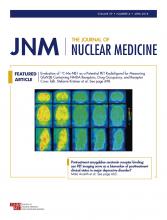REPLY: We are grateful to Finessi et al. for their letter, which raises a crucial topic. We agree that many possible confounding factors may challenge the interplay between anthracycline-induced cardiotoxicity and myocardial 18F-FDG accumulation. Among them, steroids might profoundly interfere with myocardial metabolism, increasing insulin resistance, reducing free fatty acid serum levels, and consequently potentially affecting myocardial 18F-FDG uptake (1).
On the other hand, the relevance of corticosteroids nicely fits with our hypothesis about the existence of a peculiar 18F-FDG metabolic pathway located in the endoplasmic reticulum and regulated by hexose-6-phosphate dehydrogenase (H6PD) (2). This enzyme represents the unique reticular source of the reduced nicotinamide adenine dinucleotide phosphate (NADPH) moieties needed for cortisone activation (3,4) in the same endoplasmic reticulum by 11beta-hydroxysteroid dehydrogenase type 1 (11β-HSD1). In this line, the increased use of NADPH reductive power caused by the administration of pharmacologic cortisone doses might “transiently” increase H6PD activity and thus myocardial 18F-FDG uptake. However, this variable should have played a minor role in our main observation (5) for the following reasons.
First, in our experimental animal model, in which steroids were not administered, DXR dose-dependently increased myocardial 18F-FDG accumulation. Second, as suggested by Finessi et al. in their previous study (6), the extra-steroid administration might be a strong, independent thought “transient” variable able to affect myocardial 18F-FDG accumulation. However, in our retrospective analysis, left-ventricular (LV) SUV was significantly increased in DXR-treated patients with respect to controls at the third PET study but remained persistently elevated 6 mo after chemotherapy (and eventually extra-steroid) discontinuation. Finally, and more importantly, when we focused on adriamycin, bleomycin, vincristine, dacarbazine–treated patients who accepted to undergo a later clinical evaluation, the occurrence of DXR-induced cardiotoxicity was significantly related to lower values of LV-SUV at baseline, in which patients did not received any therapy.
Altogether these observations seem to indicate that whatever its degree, the effect of cortisone therapy should have been transient and independent from baseline condition.
Footnotes
Published online Jan. 18, 2018.
- © 2018 by the Society of Nuclear Medicine and Molecular Imaging.







